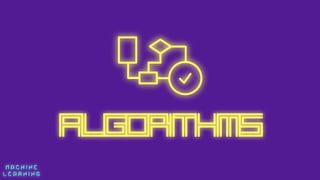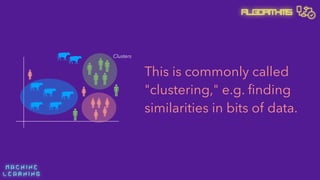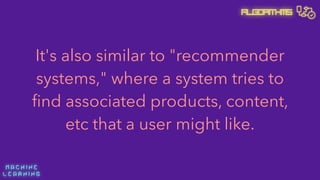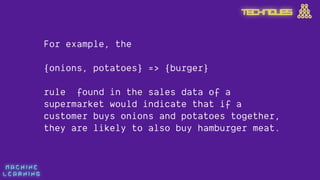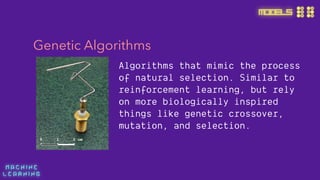Machine learning
- 1. M A C H I N E L E A R N I N G
- 2. M A C H I N E L E A R N I N G Algorithms Machine learning is a discipline focused on getting a computer to analyze data without explicit instructions, and come up with conclusions about that data.
- 3. M A C H I N E L E A R N I N G Algorithms
- 4. M A C H I N E L E A R N I N G Algorithms PROCESSES Techniques MODELS
- 5. M A C H I N E L E A R N I N G Algorithms PROCESSES Techniques MODELS
- 6. M A C H I N E L E A R N I N G Algorithms PROCESSES Techniques MODELS
- 7. M A C H I N E L E A R N I N G Algorithms PROCESSES Techniques MODELS
- 8. M A C H I N E L E A R N I N G Algorithms
- 9. M A C H I N E L E A R N I N G Algorithms An algorithm is a step by step description on how to calculate an output from an input
- 11. M A C H I N E L E A R N I N G Algorithms y = f(x)
- 12. M A C H I N E L E A R N I N G Algorithms y = 12-x This is the algorithm
- 13. M A C H I N E L E A R N I N G Algorithms y = 12-x x = 6 y = 12-6 y = 6 input: output:
- 14. M A C H I N E L E A R N I N G Algorithms y = 12-x x = 6 y = 12-6 y = 6 input: output:
- 15. M A C H I N E L E A R N I N G Algorithms y = x/2 x = 12 y = 6 let's try algorithm
- 16. M A C H I N E L E A R N I N G Algorithms y = 12-x This is the original algorithm
- 17. M A C H I N E L E A R N I N G Algorithms y = 24-x x = 24 y = 24-6 y = 18 input: output:
- 18. M A C H I N E L E A R N I N G Algorithms y = x/2 x = 24 y = 6 let's try algorithm
- 19. M A C H I N E L E A R N I N G Algorithms y = x/2 x = 24 let's try algorithm y = 6
- 20. M A C H I N E L E A R N I N G Algorithms let's try y = f(x)
- 21. M A C H I N E L E A R N I N G Algorithms y = 12-x This is the algorithm
- 22. M A C H I N E L E A R N I N G Algorithms y = (6*4-6-6)-x
- 23. M A C H I N E L E A R N I N G Algorithms x y input: output:
- 24. M A C H I N E L E A R N I N G Algorithms Supervised Reinforcement Unsupervised
- 25. M A C H I N E L E A R N I N G Algorithms Supervised machine learning is the most common. The goal is to figure out the algorithm between an input and output.
- 26. M A C H I N E L E A R N I N G Algorithms Supervised machine learning approaches two types of problems.
- 27. M A C H I N E L E A R N I N G Algorithms Classification Regression | | y = f(x) Facial detection Object recognition Speech to text Sentiment analysis Spam filtering Hardware failure Health failure Financial market shifts Customer churn prediction
- 28. M A C H I N E L E A R N I N G Algorithms Supervised Reinforcement Unsupervised
- 29. M A C H I N E L E A R N I N G Algorithms Supervised Unsupervised Boundary Clusters
- 30. M A C H I N E L E A R N I N G Algorithms The system has no y, just many bits of x (known output) (known inputs)
- 31. M A C H I N E L E A R N I N G Algorithms
- 33. M A C H I N E L E A R N I N G Algorithms Unsupervised machine learning takes arbitrary (unlabelled) data and tries to find trends and groups.
- 34. M A C H I N E L E A R N I N G Algorithms This is commonly called "clustering," e.g. finding similarities in bits of data. Clusters
- 35. M A C H I N E L E A R N I N G Algorithms Inversely, it can also be used to find anomalies. Clusters
- 36. M A C H I N E L E A R N I N G Algorithms Unsupervised machine learning is far less common, but represents the "future" of many AI applications, since most data in the world is "unlabelled."
- 37. M A C H I N E L E A R N I N G Algorithms Unsupervised machine learning is also used for "Dimensionality Reduction," e.g. reducing the number of columns in your data that aren't unique.
- 38. M A C H I N E L E A R N I N G Algorithms Supervised Reinforcement Unsupervised
- 39. M A C H I N E L E A R N I N G Algorithms Reinforcement machine learning uses a "reward system" to teach a machine to make continuously "rewarding decisions."
- 40. M A C H I N E L E A R N I N G Algorithms interpreter reward agent environment state action
- 41. M A C H I N E L E A R N I N G Algorithms This is used in many things from video games to self-driving cars.
- 42. M A C H I N E L E A R N I N G Algorithms It's also similar to "recommender systems," where a system tries to find associated products, content, etc that a user might like.
- 43. M A C H I N E L E A R N I N G Algorithms Classification Regression Clustering Dimensionality Reduction Reinforcement Learning Logistic Regression Support Vector Machines (SVM) Random Forest (RF) Naive Bayes Genetic Algorithms Principle Component Analysis (PCA) Linear Discriminant Analysis (LDA) Autoencoders Linear Regression Polynomial Regression Neural Networks Regression Trees and Random Forests K-Means Linear Discriminant Analysis Recommender Systems K-Nearest Neighbor Matrix Factorization (Stochastic Gradient Descent, Alternating Least Squares) Association Rules (Apriori, Elcat) Deep Neural Networks Q-Learning State-Action-Reward-State-Action (SARSA) Deep Q Network (DQN) Deep Deterministic Policy Gradient (DDPG)
- 44. M A C H I N E L E A R N I N G processes
- 45. M A C H I N E L E A R N I N G PROCESSES Let's train a system to figure out whether an alcohol is 🍷wine or 🍺 beer.
- 46. M A C H I N E L E A R N I N G All machine learning starts with some form of "data." PROCESSES
- 47. M A C H I N E L E A R N I N G 🍺 🍷 Attribute 1: Color (as a wavelength of light) Attribute 2: Alcohol by Volume (as a percentage) PROCESSES
- 48. M A C H I N E L E A R N I N G Next, we go to the grocery store and get beer and wine, to gather data. PROCESSES
- 49. M A C H I N E L E A R N I N G Color (nm) Alcohol % Beer or Wine? 610 5 Beer 599 13 Wine 693 14 Wine PROCESSES
- 50. M A C H I N E L E A R N I N G We then get the data into format & location suitable for machine learning. This is called data preparation. PROCESSES
- 51. M A C H I N E L E A R N I N G 1. Collect Data 2. Randomize Order 3. Visualize Data to look for pre-existing patterns 4. Split data into "training" and "performance testing" sets. PROCESSES
- 52. M A C H I N E L E A R N I N G Next we choose a model. I'll talk about this more later, for now, let's use a simple one. PROCESSES
- 53. M A C H I N E L E A R N I N G Then we move onto training. (the bulk of the process) PROCESSES
- 54. M A C H I N E L E A R N I N G 0 5 10 15 20 550 575 600 625 650 PROCESSES
- 55. M A C H I N E L E A R N I N G y = m(x) + b output slope input y-intercept PROCESSES
- 56. M A C H I N E L E A R N I N G 0 5 10 15 20 550 575 600 625 650 PROCESSES
- 57. M A C H I N E L E A R N I N G y = m(x) + b output slope input y-intercept Weight: Multiplied Value Bias: Added to the end result slope y-intercept PROCESSES
- 58. M A C H I N E L E A R N I N G We then tweak weights and biases in the algorithm to be more accurate. PROCESSES
- 59. M A C H I N E L E A R N I N G training data model prediction test & update weights & biases PROCESSES
- 60. M A C H I N E L E A R N I N G Finally, we evaluate the results and modify as needed, tuning parameters where necessary (like number of training loops). PROCESSES
- 61. M A C H I N E L E A R N I N G Final result: a functional machine learning model. model prediction Color: 660nm ABV: 12% 🍷 PROCESSES
- 62. M A C H I N E L E A R N I N G technIques
- 63. M A C H I N E L E A R N I N G TECHNIQUES Feature Learning The ability of a system to automatically detect classifications in raw data.
- 64. M A C H I N E L E A R N I N G Sparse Dictionary Learning Learning a more generic representation of input data that gets rid of noise and outliers. TECHNIQUES
- 65. M A C H I N E L E A R N I N G TECHNIQUES
- 66. M A C H I N E L E A R N I N G Anomaly Detection Identification of rare items, events or observations which raise suspicions by differing significantly from the majority of the data. TECHNIQUES
- 67. M A C H I N E L E A R N I N G Decision Trees Determining a likelihood particular outcome based on a set of observations. TECHNIQUES
- 68. M A C H I N E L E A R N I N G Your chances of survival were good if you were (i) a female or (ii) a male younger than 9.5 years with less than 2.5 siblings. Titanic Survival Decision Tree TECHNIQUES
- 69. M A C H I N E L E A R N I N G Association Rules Discovers interesting relations between variables in large databases TECHNIQUES
- 70. M A C H I N E L E A R N I N G For example, the {onions, potatoes} => {burger} rule found in the sales data of a supermarket would indicate that if a customer buys onions and potatoes together, they are likely to also buy hamburger meat. TECHNIQUES
- 71. M A C H I N E L E A R N I N G MODELS
- 72. M A C H I N E L E A R N I N G MODELS Artificial Neural Networks A framework for many different machine learning algorithms to work together and process complex data inputs.
- 73. M A C H I N E L E A R N I N G MODELS Support Vector Machines Finds a way to accurately split classes of data, before it is processed further.
- 74. M A C H I N E L E A R N I N G MODELS Bayesian Networks Known as "belief" or "causal" networks. They predict outputs with multiple inputs, taking into account how inputs affect each other.
- 75. M A C H I N E L E A R N I N G MODELS Bayesian Networks
- 76. M A C H I N E L E A R N I N G MODELS Genetic Algorithms Algorithms that mimic the process of natural selection. Similar to reinforcement learning, but rely on more biologically inspired things like genetic crossover, mutation, and selection.
- 77. M A C H I N E L E A R N I N G
- 78. M A C H I N E L E A R N I N G questions








